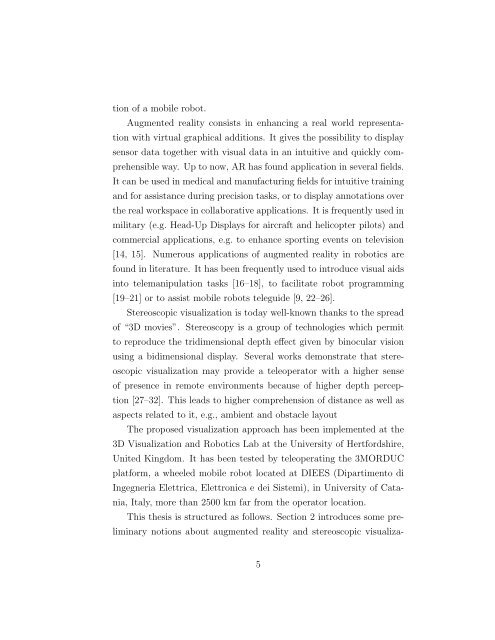Scarica (PDF – 6.19 MB)
Scarica (PDF – 6.19 MB)
Scarica (PDF – 6.19 MB)
Create successful ePaper yourself
Turn your PDF publications into a flip-book with our unique Google optimized e-Paper software.
tion of a mobile robot.<br />
Augmented reality consists in enhancing a real world representa-<br />
tion with virtual graphical additions. It gives the possibility to display<br />
sensor data together with visual data in an intuitive and quickly com-<br />
prehensible way. Up to now, AR has found application in several fields.<br />
It can be used in medical and manufacturing fields for intuitive training<br />
and for assistance during precision tasks, or to display annotations over<br />
the real workspace in collaborative applications. It is frequently used in<br />
military (e.g. Head-Up Displays for aircraft and helicopter pilots) and<br />
commercial applications, e.g. to enhance sporting events on television<br />
[14, 15]. Numerous applications of augmented reality in robotics are<br />
found in literature. It has been frequently used to introduce visual aids<br />
into telemanipulation tasks [16<strong>–</strong>18], to facilitate robot programming<br />
[19<strong>–</strong>21] or to assist mobile robots teleguide [9, 22<strong>–</strong>26].<br />
Stereoscopic visualization is today well-known thanks to the spread<br />
of “3D movies”. Stereoscopy is a group of technologies which permit<br />
to reproduce the tridimensional depth effect given by binocular vision<br />
using a bidimensional display. Several works demonstrate that stere-<br />
oscopic visualization may provide a teleoperator with a higher sense<br />
of presence in remote environments because of higher depth percep-<br />
tion [27<strong>–</strong>32]. This leads to higher comprehension of distance as well as<br />
aspects related to it, e.g., ambient and obstacle layout<br />
The proposed visualization approach has been implemented at the<br />
3D Visualization and Robotics Lab at the University of Hertfordshire,<br />
United Kingdom. It has been tested by teleoperating the 3MORDUC<br />
platform, a wheeled mobile robot located at DIEES (Dipartimento di<br />
Ingegneria Elettrica, Elettronica e dei Sistemi), in University of Cata-<br />
nia, Italy, more than 2500 km far from the operator location.<br />
This thesis is structured as follows. Section 2 introduces some pre-<br />
liminary notions about augmented reality and stereoscopic visualiza-<br />
5




